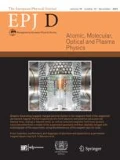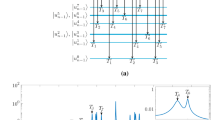Abstract.
A simplified scheme for the investigation of cooperative effects in the quantum jump statistics of small numbers of fluorescing atoms and ions in a trap is presented. It allows the analytic treatment of three dipole-dipole interacting four-level systems which model the relevant level scheme of Ba+ ions. For the latter, a huge rate of double and triple jumps was reported in a former experiment and the huge rate was attributed to the dipole-dipole interaction. Our theoretical results show that the effect of the dipole-dipole interaction on these rates is at most 5% and that for the parameter values of the experiment there is practically no effect. Consequently it seems that the dipole-dipole interaction can be ruled out as a possible explanation for the huge rates reported in the experiment.
Similar content being viewed by others
References
See references in references AdBeDaHe:01, FiTa:02
H.G. Dehmelt, Bull. Am Phys. Soc. 20, 60 (1975); for extensive references cf., e.g., BeHe:99
T. Sauter, R. Blatt, W. Neuhauser, P.E. Toschek, Opt. Commun. 60, 287 (1986)
T. Sauter, Beobachtung von Quantensprüngen in der Resonanzfluoreszenz einzelner Ba+ -Ionen, Ph.D. thesis, Universität Hamburg, 1987
B.H.W. Hendriks, G. Nienhus, J. Mod. Opt. 35, 1331 (1988)
M. Lewenstein, J. Javanainen, Phys. Rev. Lett. 59, 1289 (1987)
M. Lewenstein, J. Javanainen, IEEE J. Quant. Electr. 42, 1403 (1988)
G.S. Agarwal, S.V. Lawande, R. D'Souza, IEEE J. Quant. Electron. 24, 1413 (1988)
S.V. Lawande, Q.V. Lawande, B.N. Jagatap, Phys. Rev. A 40, 3434 (1989)
C. Fu, C. Gong, Phys. Rev. A 45, 5095 (1992)
R.C. Thompson, D.J. Bates, K. Dholakia, D.M. Segal, D.C. Wilson, Phys. Scripta 46, 285 (1992)
W.M. Itano, J.C. Bergquist, D.J. Wineland, Phys. Rev. A 38, 559 (1988)
M. Block, O. Rehm, P. Seibert, G. Werth, Eur. Phys. J. D 7, 461 (1999)
C.J.S. Donald et al., Europhys. Lett. 51, 388 (2000)
D.J. Berkeland, D.A. Raymondson, V.M. Tassin, Phys. Rev. A 69, 052103 (2004)
C. Skornia, J. von Zanthier, G.S. Agarwal, E. Werner, H. Walther, Phys. Rev. A 64, 053803 (2001)
A. Beige, G.C. Hegerfeldt, Phys. Rev. A 59, 2385 (1999)
S. Addicks, A. Beige, M. Dakna, G.C. Hegerfeldt, Eur. Phys. J. D 15, 393 (2001)
T. Sauter, W. Neuhauser, R. Blatt, P.E. Toschek, Phys. Rev. Lett. 57, 1696 (1986)
V. Hannstein, G.C. Hegerfeldt, Phys. Rev. A 68, 043826 (2003)
C. Skornia, J. von Zanthier, G.S. Agarwal, E. Werner, H. Walther, Europhys. Lett. 56, 665 (2001)
V. Hannstein, G.C. Hegerfeldt, Phys. Rev. A 70, 023820 (2004)
G.C. Hegerfeldt, Phys. Rev. A 47, 449 (1993)
G.C. Hegerfeldt, T.S. Wilser, in: Classical and Quantum Systems. Proceedings of the Second International Wigner Symposium, July 1991, edited by H.D. Doebner, W. Scherer, F. Schroeck (World Scientific, Singapore, 1992), p. 104; G.C. Hegerfeldt, Phys. Rev. A 47, 449 (1993); G.C. Hegerfeldt, D.G. Sondermann, Quant. Semiclass. Opt. 8, 121 (1996); for a review cf. M.B. Plenio, P.L. Knight, Rev. Mod. Phys. 70, 101 (1998); the quantum jump approach is essentially equivalent to the Monte-Carlo wavefunction approach of J. Dalibard, Y. Castin, K. Mølmer, Phys. Rev. Lett. 68, 580 (1992); and to the quantum trajectories of H. Carmichael, An Open Systems Approach to Quantum Optics, Lecture Notes in Physics m18 (Springer, Berlin, 1993)
G.C. Hegerfeldt, M.B. Plenio, Phys. Rev. A 47, 2186 (1993)
Z. Ficek, R. Tanaś, Phys. Rep. 372, 369 (2002)
Author information
Authors and Affiliations
Corresponding author
Rights and permissions
About this article
Cite this article
Hannstein, V., Hegerfeldt, G. Simplified approach to double jumps for fluorescing dipole-dipole interacting atoms. Eur. Phys. J. D 38, 415–422 (2006). https://doi.org/10.1140/epjd/e2006-00076-4
Received:
Published:
Issue Date:
DOI: https://doi.org/10.1140/epjd/e2006-00076-4




